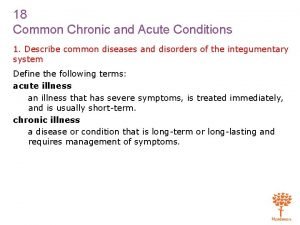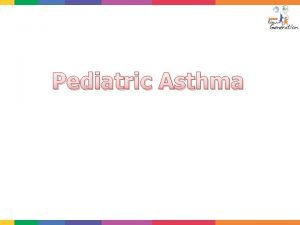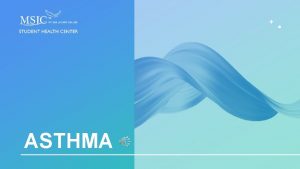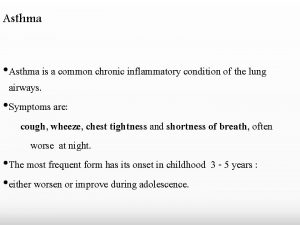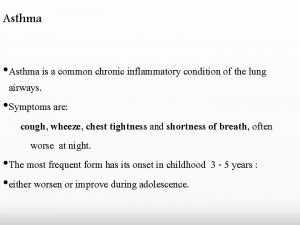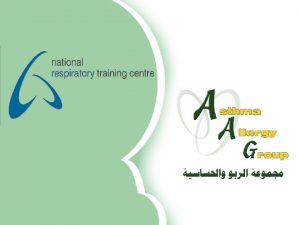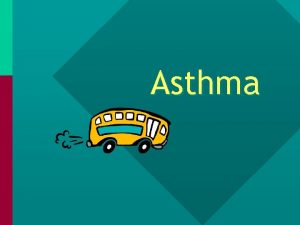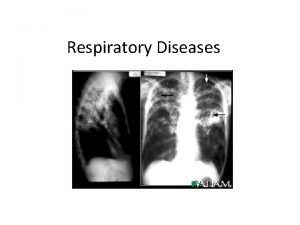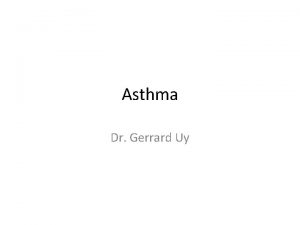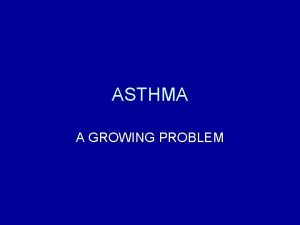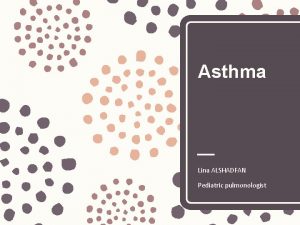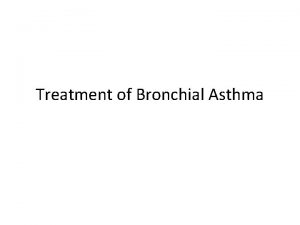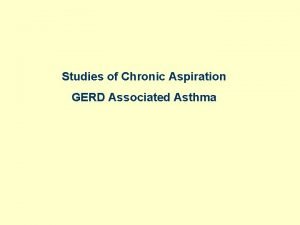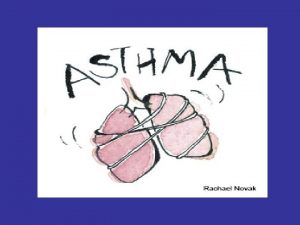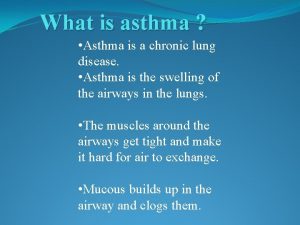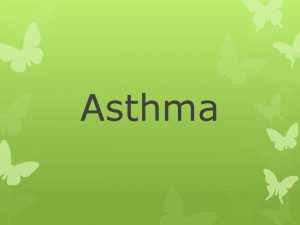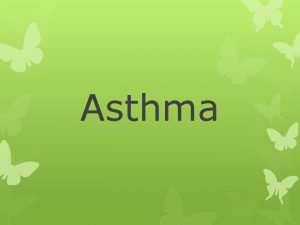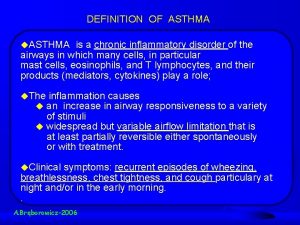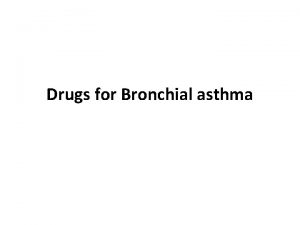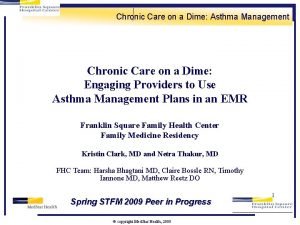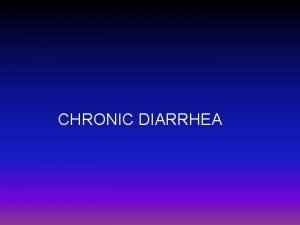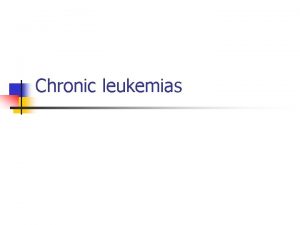Asthma Overview Asthma is the most common chronic









































- Slides: 41

Asthma: Overview ■ Asthma is the most common chronic respiratory disorder in childhood, affecting 15– 20% of children. ■ Worldwide there has been a significant increase in the incidence of asthma over the last 40 years ■ Typically develops in childhood-50% before 3 years of age, and the majority before 8 years of age.


Peak flow metery

Pathogenesis ■ Airway inflammation also contributes to airflow limitation, which includes: • Bronchoconstriction • Edema • Chronic mucus plugging • Airway wall remodeling ■ All this leads to bronchial obstruction

Clinical features Asthma should be suspected in any child with wheezing on more than one occasion. Other key features associated child having asthma include: ■ • Symptoms worse at night and in the early morning ■ • Symptoms that have triggers (e. g. exercise, pets, dust, cold air, emotions. ■ • Interval symptoms, i. e. symptoms between acute exacerbation. ■ • Personal or family history of an atopic disease ■ • Positive response to asthma therapy. ■

Patterns of Asthma According to ■ ■ ■ • How frequent are the symptoms? • What triggers the symptoms? Specifically, are sport and general activities affected by the asthma? • How often is sleep disturbed by asthma? • How severe are the interval symptoms between exacerbations? • How much school has been missed due to asthma?

Examination of the chest is usually normal between attacks. ■ In long-standing asthma there may be hyperinflation of the chest. ■ generalised polyphonic expiratory wheeze and a prolonged expiratory phase. ■ Onset of the disease in early childhood may result in Harrison sulci. ■ Evidence of eczema and allergic rhinitid should be sought, ■. Growth should be plotted but is normal unless the asthma is extremely severe. ■





Function Testing ■ Determines ■ Degree of airway obstruction ■ Other lung disorders















Bronchodilator therapy Inhaled β 2 -agonists are the most commonly used and most effective bronchodilators. Short-actingβ 2 -agonists ■ have a rapid onset of action, effective for 2– 4 h ■ have few side-effects. ■ They are used as required for increased symptoms, and in high doses for acute asthma attacks. long-actingβ 2 -agonists (LABAs)such as salmeterol or formoterol are effective for 12 h. ■ They are not used in acute asthma, and ■ should not be used without an inhaled cortico. ■ LABAs are useful in exercise-induced asthma. ■


Ipratropium bromide ■ ■ an anticholinergic bronchodilator, is sometimes given to young infants when other bronchodilators are found to be ineffective, or in the treatment of severe acute asthma.

Treatment—Inhaled Steroids ■ Inhaled corticosteroids are standard of care for all categories except for mild intermittent asthma • Long term prevention of symptoms; suppression, control and reversal of inflammation. • Block late reaction to allergen • Reduce airway hyperresponsiveness • Inhibit inflammatory cell migration and activation • Increase B 2 receptor affinity

Otherapies Oral prednisolone, usually given on alternate days to minimise the adverse effect on height, is required only in severe persistent asthma where other treatment has failed. ■ Anti-Ig. E therapy (omalizumab ) is an injectable monoclonal antibody that acts against Ig. E, the natural antibody that mediates allergy. ■ It is used for the treatment of severe atopic asthma, and should only be administered by a specialist in childhood asthma. Antibiotics: are of no value ■





Add-on therapy LABA: ■ The first choice of add-on therapy in a child over 5 years ■ leukotriene receptor antagonist such as montelukast is Recommended in children under 5 years. Also used when LABA fails to control symptoms. ■ Slow-release oral theophyllineis an alternative; however, it has a high incidence of sideeffects (vomiting, insomnia, headaches, poor concentration), so it is not commonly used in children. ■

Inhaled Steroids ■ Budesonide (Pulmicort®) ■ Fluticasone propionate (Flovent®) ■ Mometasone (Asmanex®) ■ Beclomethsasone (Qvar®) ■ Ciclesonide (Alvesco®) ■ Flunisolide (Aerospan®) ■ Fluticasone furoate (Arnuity Ellipta®)

Combination Therapy ■ Fluticasone + Salmeterol (Advair®) ■ Budesonide +Formoterol (Symbicort®) ■ Mometasone +Formoterol (Dulera®) ■ Fluticasone +Salmeterol (Air. Duo Respiclick®)



 Pathophysiology definition
Pathophysiology definition 18 common chronic and acute conditions
18 common chronic and acute conditions What is the greatest common factor of 12 and 42
What is the greatest common factor of 12 and 42 Common anode and common cathode
Common anode and common cathode Prime factors of 72
Prime factors of 72 Highest common factors and lowest common multiples
Highest common factors and lowest common multiples Lcm of 6 and 12
Lcm of 6 and 12 Multiples of 9 and 21
Multiples of 9 and 21 Hình ảnh bộ gõ cơ thể búng tay
Hình ảnh bộ gõ cơ thể búng tay Bổ thể
Bổ thể Tỉ lệ cơ thể trẻ em
Tỉ lệ cơ thể trẻ em Chó sói
Chó sói Glasgow thang điểm
Glasgow thang điểm Bài hát chúa yêu trần thế alleluia
Bài hát chúa yêu trần thế alleluia Các môn thể thao bắt đầu bằng từ đua
Các môn thể thao bắt đầu bằng từ đua Thế nào là hệ số cao nhất
Thế nào là hệ số cao nhất Các châu lục và đại dương trên thế giới
Các châu lục và đại dương trên thế giới Công của trọng lực
Công của trọng lực Trời xanh đây là của chúng ta thể thơ
Trời xanh đây là của chúng ta thể thơ Mật thư anh em như thể tay chân
Mật thư anh em như thể tay chân Làm thế nào để 102-1=99
Làm thế nào để 102-1=99 độ dài liên kết
độ dài liên kết Các châu lục và đại dương trên thế giới
Các châu lục và đại dương trên thế giới Thơ thất ngôn tứ tuyệt đường luật
Thơ thất ngôn tứ tuyệt đường luật Quá trình desamine hóa có thể tạo ra
Quá trình desamine hóa có thể tạo ra Một số thể thơ truyền thống
Một số thể thơ truyền thống Cái miệng nó xinh thế
Cái miệng nó xinh thế Vẽ hình chiếu vuông góc của vật thể sau
Vẽ hình chiếu vuông góc của vật thể sau Thế nào là sự mỏi cơ
Thế nào là sự mỏi cơ đặc điểm cơ thể của người tối cổ
đặc điểm cơ thể của người tối cổ V cc cc
V cc cc Vẽ hình chiếu đứng bằng cạnh của vật thể
Vẽ hình chiếu đứng bằng cạnh của vật thể Tia chieu sa te
Tia chieu sa te Thẻ vin
Thẻ vin đại từ thay thế
đại từ thay thế điện thế nghỉ
điện thế nghỉ Tư thế ngồi viết
Tư thế ngồi viết Diễn thế sinh thái là
Diễn thế sinh thái là Các loại đột biến cấu trúc nhiễm sắc thể
Các loại đột biến cấu trúc nhiễm sắc thể Các số nguyên tố
Các số nguyên tố Tư thế ngồi viết
Tư thế ngồi viết

